 It has long been thought that the home team has a significant advantage in football matches, thanks to the fact that the majority of people in attendance will be putting their support behind them. The question is, does it make that much of a difference? After all, the pitch is pretty much the same size, the rules of the game remain the same and the officials should, in theory at least, referee the match to the same standards as always.
It has long been thought that the home team has a significant advantage in football matches, thanks to the fact that the majority of people in attendance will be putting their support behind them. The question is, does it make that much of a difference? After all, the pitch is pretty much the same size, the rules of the game remain the same and the officials should, in theory at least, referee the match to the same standards as always.
The home crowd will be understandably partisan, which might give their team a morale boost when it’s most needed and could potentially influence the referee’s decision making. Other than that, is there really all that much that means that home advantage truly is a big thing that has to be considered when weighing up the likely outcome of a football match? Or won’t it matter to the better teams?
The best way of gaining some idea as to how big an advantage is presented by playing at home is by looking at the statistics on the matter. In order to do that, we’ve taken a look at five seasons’ worth of results and broken them down into home wins, away wins and draws. We’ve deliberately left out the 2020-2021 campaign, for reasons that we’ll come to after we’ve looked at the seasons in question.
How Often Does the Home Team Win in Football?
In the five seasons between 2015-16 and 2019-20, the home team won in 45.8% of Premier League matches and 43.3% of EFL Championship matches.
Across Europe’s top leagues during the same five seasons, Spain’s La Liga had the highest percentage of home wins with 46.6%, followed by the French Ligue 1 with 45.4%, Germany’s Bundesliga with 44.8%, and Italy’s Serie A with 44.6%.
The Premier League
Let’s start by taking a look at the results in the Premier League, with England’s top-flight being considered to be one of the most exciting and passionate divisions in world football. The fans react to the ebb and flow of the matches, rather than just making a constant noise as is the case in some other leagues we’ll look at. Does this sense of partisanship make a difference?
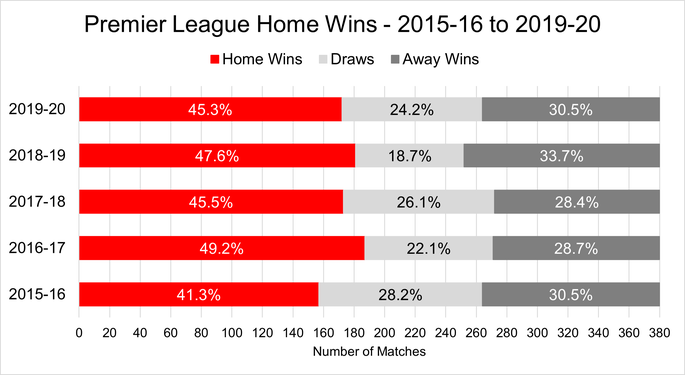
We looked at 1,900 matches over the course of five seasons, of which 870 ended with a win for the home side. That works out as about 45.8% of games that were won by the home team in the Premier League, compared to 577, or 30.4%, matches that ended in an away win. It certainly suggests that there is a bias towards the home sides in the English top-flight, but what about other divisions?
The Championship
The second-tier of football in England is one where the skill level is, by definition, slightly less than you would find in the Premier League. It’s also true that capacities aren’t as impressive in the Championship, though the supporters are still passionate and very much get behind their teams. The question is, does that have much of an impact when it comes to the sphere of home advantage?
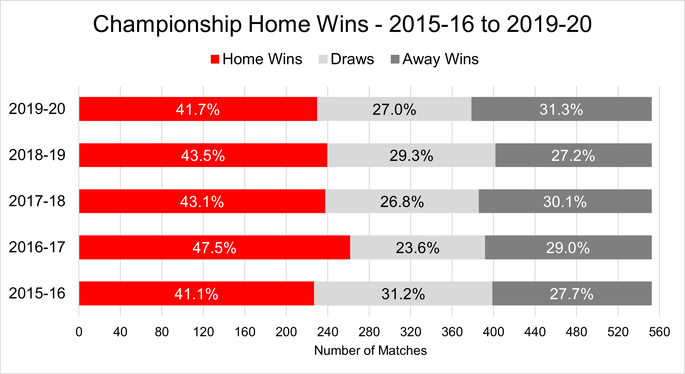
Across the 2,760 matches that we looked at in the Championship, there were 1,197 home wins. That equates to roughly 43.4% of matches ending in the favour of the home side, compared to the 802 away wins, which is 29.1% of all the games. It certainly suggests that home advantage is a big factor in the Championship, though not quite as big as we saw when looking at Premier League matches.
Spanish La Liga
If there’s one division that is thought of as being as full of thrills and spills as the Premier League then it is unquestionably La Liga. Spanish football is thought of as being filled with flair and excitement, so you would imagine that home advantage doesn’t count for quite as much as in other leagues. Is it a matter of the best team always wins, or can the home crowd be a bit more influential than that?
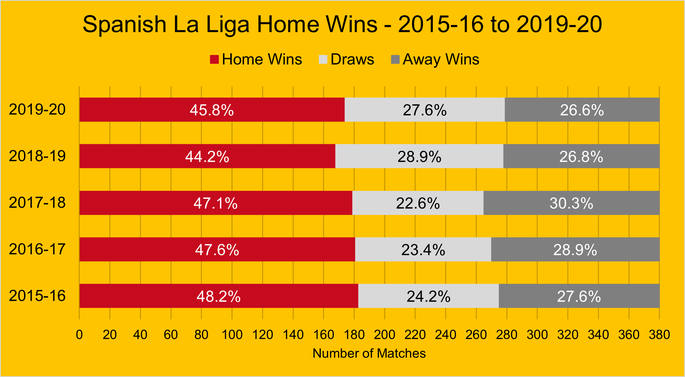
As with the Premier League, La Liga plays 380 matches during its main season, which equates to 1,900 games over the course of five years. Of those, 885 were won by the home team, which is 46.6%. There were 533 games won by the away side, or 28.1%. Again, a sense of home advantage is clear, though perhaps it remains not quite as pronounced as some might imagine.
German Bundesliga
Elsewhere on the site you can read about how often both teams score in football matches, with the Bundesliga surprisingly being one of the divisions where it happens most often. German football is perhaps more exciting than many people give it credit for, though it is true to say that the crowds tend to make continuous noise rather than react to what it taking place in front of them. Does that make a difference for home advantage?
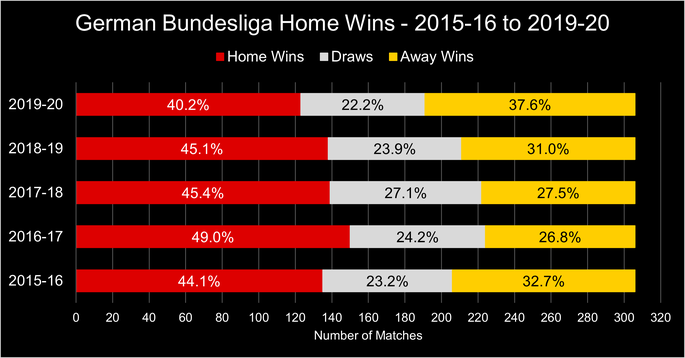
It’s entirely fair to point out that the Bundesliga has a much more sporadic sense of home advantage, which alters from year to year. It’s why it’s important to take a look at the figures from across the five years, during which time 1,530 matches were played. Of those, 685 ended up in a win for the home side, which is about 44.8%. The away side, on the other hand, won 476 games, which equates to roughly 31.1% of all matches played.
Italian Serie A
Italian football is generally thought of as being a more considered version of the game, with defending being the main priority of the teams involved. In the Both Teams To Score piece that you can read elsewhere on the site, the Italians came out on top as featuring the most matches in which that happens, suggesting that the ebb and flow of the matches is more balanced. How does that translate when it comes to home advantage?
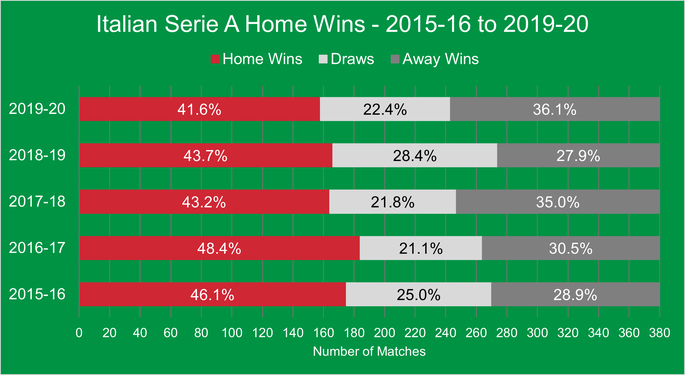
As with the Premier League and La Liga, the Italian top-flight sees 380 games played every season, which equates to 1,900 matches when you’re looking at five seasons in total. Of those, 847 of them, or 44.6%, were won by the home team. That compares to 602, or 31.7% of games that were won by the away side. Once again, there is a degree of home advantage playing out across the campaigns.
French Ligue 1
There is a large amount of disrespect shown towards the French top-flight by English audiences, thanks in no small part to the fact that Paris Saint Germain tend to outspend all of their rivals. In the rest of the division, however, there is a sense that it is quite even, so it wouldn’t be unreasonable to assume that home advantage doesn’t play as big a part as it might elsewhere in Europe. Is that the case?
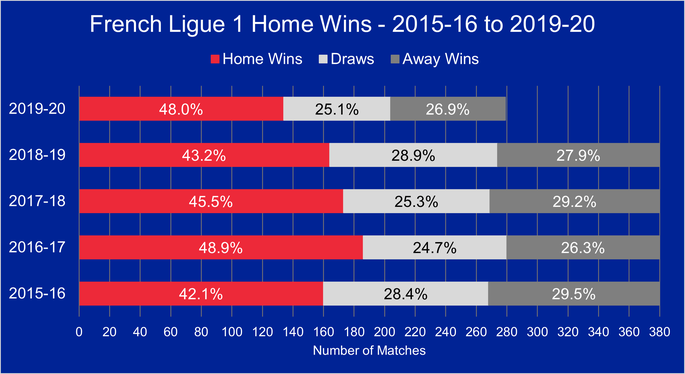
France was the only country on our list to curtail their season during the 2019-2020 campaign, owing to the state of the world at the time. As a result, they played 1,799 matches during the five seasons that we’re looking at. Of those, 817 ended in homes wins, which was 45.4% of the games. In contrast, 504 ended in an away win, which was 28.0% of the matches played.
Comparing Leagues
Now that we’ve looked at all of the main European leagues separately, let’s have a look at how they compare when we put them alongside each other. Is there a clear sense of home advantage being the case in some leagues more than others, or is it the case that they all boast roughly similar numbers in terms of the amount of home wins and away wins over the course of five seasons?
Home Wins in Europe’s Top Leagues – 2015/16 to 2019/20
| Season | Premier League | Championship | La Liga | Bundesliga | Serie A | Ligue 1 |
|---|---|---|---|---|---|---|
| 2019-2020 | 45.26% | 41.66% | 45.78% | 40.19% | 41.57% | 48.02% |
| 2018-2019 | 47.63% | 43.47% | 44.21% | 45.09% | 43.68% | 43.15% |
| 2017-2018 | 45.52% | 43.11% | 47.10% | 45.42% | 43.15% | 45.52% |
| 2016-2017 | 49.21% | 47.46% | 47.63% | 49.01% | 48.42% | 48.94% |
| 2015-2016 | 41.31% | 41.12% | 48.15% | 44.11% | 46.05% | 42.10% |
| Total | 45.78% | 43.36% | 46.57% | 44.77% | 44.57% | 45.41% |
There were 11,789 matches played across all of the leagues that we’re looking at and the five seasons that we’re investigating. In total, 5,301 matches ended with a win for the home team, which is 44.96% of all games. When it came to away wins, 3,494 of the games played ended that way, or 29.63%. The answer to the question ‘how big is home advantage’ then, is that it leads to about 15.33% more wins than for the away sides.
The 2020-2021 Season
Earlier in the piece we mentioned that would look at the 2020-2021 season separately to the rest of the campaigns. This is because the state of the world at the time meant that the majority of the season was played behind closed doors across Europe. Given the lack of fans in the majority of countries for most of the campaign, it is the perfect way to discern whether or not home advantage really does play a major part in the outcome of matches.
Here’s a look at the season for each of the leagues that we’ve looked at above, which should give us more information about how home advantage wasn’t as clear without supporters in the grounds:
Home Wins in the 2020/21 Season
| League | Home Win % | Draw % | Away Win % |
|---|---|---|---|
| Premier League | 37.89% | 21.85% | 40.26% |
| Championship | 41.12% | 25.19% | 33.69% |
| La Liga | 41.57% | 28.70% | 29.73% |
| Bundesliga | 42.15% | 26.48% | 31.37% |
| Serie A | 41.05% | 25.27% | 33.68% |
| Ligue 1 | 37.36% | 25.01 | 37.63% |
Out of the six years we’re now looking at, the 2020-2021 season was the only one in which there were more wins for the away sides than the home teams in both the Premier League and Ligue 1. The difference between the other leagues was much closer than in the past, too. Over the six leagues we’re looking at, there were 2,378 matches played. Of those, 956 ended up in wins for the home team, which is roughly 40.20%.
In contrast, there were 819 wins for the away team, which amounts to about 34.44% of games. That means 40.20% of wins in 2020-2021 against the 44.96% over the other five season, as well as 34.44% away wins up against the 29.63% across the other five campaigns. That is a difference of 5.76%, compared to the 15.33% when looking at the other five seasons.
It is, therefore, entirely fair to say that home advantage makes a big difference when considering most leagues in Europe. When fans weren’t in the ground, the number of wins achieved by the home sides dropped by around 10% and in two of the divisions we’ve looked at the wins for the away side were more than the home side, which hadn’t happened at any other point. Next time you go to a match, then, you should shout a little bit louder.
